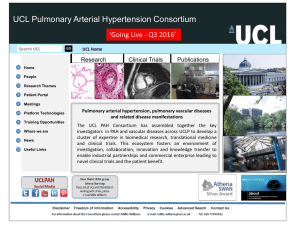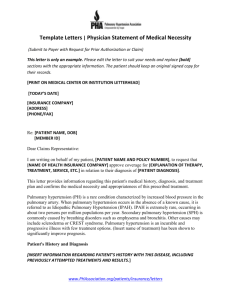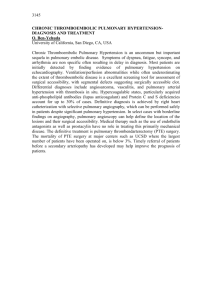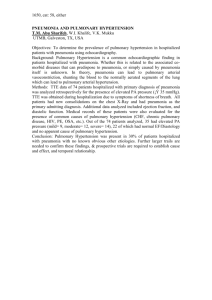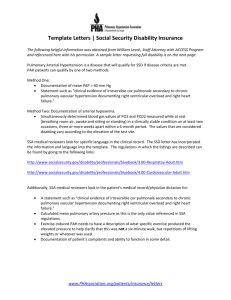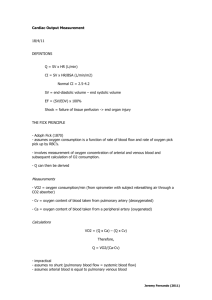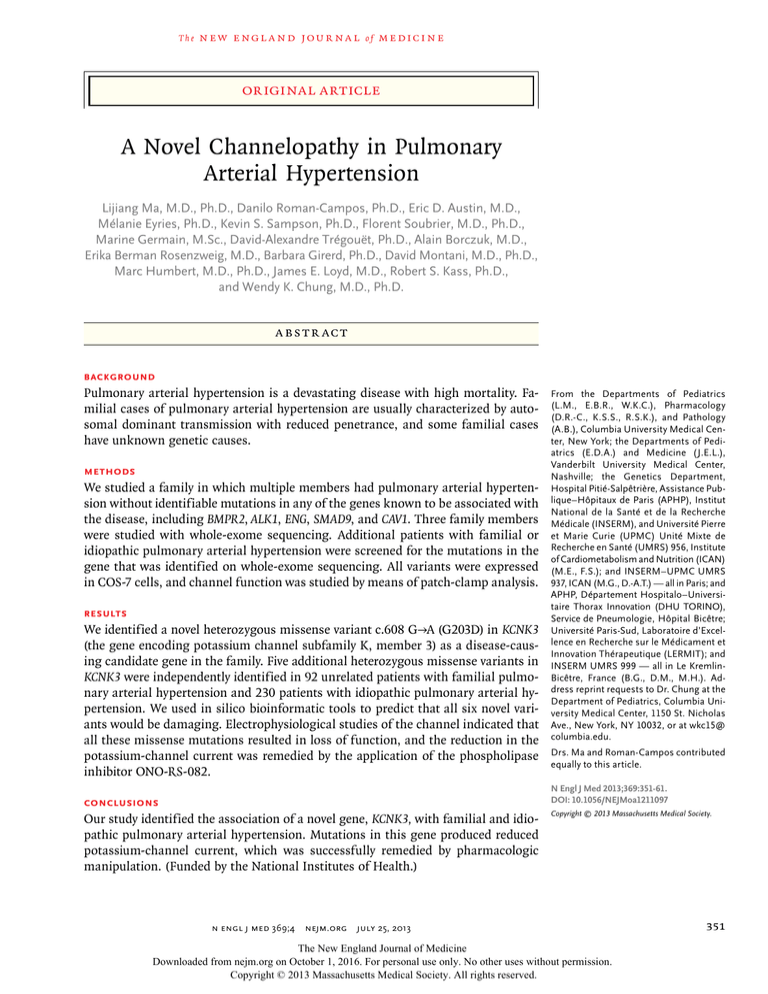
The
n e w e ng l a n d j o u r na l
of
m e dic i n e
original article
A Novel Channelopathy in Pulmonary
Arterial Hypertension
Lijiang Ma, M.D., Ph.D., Danilo Roman-Campos, Ph.D., Eric D. Austin, M.D.,
Mélanie Eyries, Ph.D., Kevin S. Sampson, Ph.D., Florent Soubrier, M.D., Ph.D.,
Marine Germain, M.Sc., David-Alexandre Trégouët, Ph.D., Alain Borczuk, M.D.,
Erika Berman Rosenzweig, M.D., Barbara Girerd, Ph.D., David Montani, M.D., Ph.D.,
Marc Humbert, M.D., Ph.D., James E. Loyd, M.D., Robert S. Kass, Ph.D.,
and Wendy K. Chung, M.D., Ph.D.
A bs t r ac t
Background
Pulmonary arterial hypertension is a devastating disease with high mortality. Familial cases of pulmonary arterial hypertension are usually characterized by autosomal dominant transmission with reduced penetrance, and some familial cases
have unknown genetic causes.
Methods
We studied a family in which multiple members had pulmonary arterial hypertension without identifiable mutations in any of the genes known to be associated with
the disease, including BMPR2, ALK1, ENG, SMAD9, and CAV1. Three family members
were studied with whole-exome sequencing. Additional patients with familial or
idiopathic pulmonary arterial hypertension were screened for the mutations in the
gene that was identified on whole-exome sequencing. All variants were expressed
in COS-7 cells, and channel function was studied by means of patch-clamp analysis.
Results
We identified a novel heterozygous missense variant c.608 G→A (G203D) in KCNK3
(the gene encoding potassium channel subfamily K, member 3) as a disease-causing candidate gene in the family. Five additional heterozygous missense variants in
KCNK3 were independently identified in 92 unrelated patients with familial pulmonary arterial hypertension and 230 patients with idiopathic pulmonary arterial hypertension. We used in silico bioinformatic tools to predict that all six novel variants would be damaging. Electrophysiological studies of the channel indicated that
all these missense mutations resulted in loss of function, and the reduction in the
potassium-channel current was remedied by the application of the phospholipase
inhibitor ONO-RS-082.
From the Departments of Pediatrics
(L.M., E.B.R., W.K.C.), Pharmacology
(D.R.-C., K.S.S., R.S.K.), and Pathology
(A.B.), Columbia University Medical Center, New York; the Departments of Pediatrics (E.D.A.) and Medicine (J.E.L.),
Vanderbilt University Medical Center,
Nashville; the Genetics Department,
Hospital Pitié-Salpêtrière, Assistance Publique–Hôpitaux de Paris (APHP), Institut
National de la Santé et de la Recherche
Médicale (INSERM), and Université Pierre
et Marie Curie (UPMC) Unité Mixte de
Recherche en Santé (UMRS) 956, Institute
of Cardiometabolism and Nutrition (ICAN)
(M.E., F.S.); and INSERM–UPMC UMRS
937, ICAN (M.G., D.-A.T.) — all in Paris; and
APHP, Département Hospitalo–Universitaire Thorax Innovation (DHU TORINO),
Service de Pneumologie, Hôpital Bicêtre;
Université Paris-Sud, Laboratoire d’Excel­
lence en Recherche sur le Médicament et
Innovation Thérapeutique (LERMIT); and
INSERM UMRS 999 — all in Le KremlinBicêtre, France (B.G., D.M., M.H.). Address reprint requests to Dr. Chung at the
Department of Pediatrics, Columbia University Medical Center, 1150 St. Nicholas
Ave., New York, NY 10032, or at wkc15@
columbia.edu.
Drs. Ma and Roman-Campos contributed
equally to this article.
N Engl J Med 2013;369:351-61.
DOI: 10.1056/NEJMoa1211097
Conclusions
Our study identified the association of a novel gene, KCNK3, with familial and idiopathic pulmonary arterial hypertension. Mutations in this gene produced reduced
potassium-channel current, which was successfully remedied by pharmacologic
manipulation. (Funded by the National Institutes of Health.)
Copyright © 2013 Massachusetts Medical Society.
n engl j med 369;4 nejm.org july 25, 2013
The New England Journal of Medicine
Downloaded from nejm.org on October 1, 2016. For personal use only. No other uses without permission.
Copyright © 2013 Massachusetts Medical Society. All rights reserved.
351
The
P
n e w e ng l a n d j o u r na l
ulmonary arterial hypertension is
a rare disease that is characterized by increased pulmonary-artery pressure in the
absence of common causes of pulmonary hypertension, such as chronic heart, lung, or thromboembolic disease.1 Before the advent of novel therapies, patients with idiopathic or familial pulmonary
arterial hypertension had an estimated median
survival of 2.8 years, with 1-year, 3-year, and
5-year survival rates of 68%, 48%, and 34%, respectively.2 However, despite progress in treatment, pulmonary arterial hypertension remains
a progressive, fatal disease. The clinical presentation can be nonspecific, and patients often receive a diagnosis late in their clinical course.
The cause of pulmonary arterial hypertension is
heterogeneous, and some cases are familial. Molecular genetic studies have shown that mutations
in the gene encoding bone morphogenetic protein
receptor type II (BMPR2) are present in approximately 70% of patients with familial pulmonary
arterial hypertension, as well as in 10 to 25% of
those with idiopathic pulmonary arterial hypertension.3-5 Pulmonary arterial hypertension may also
occur in patients carrying mutations in the gene
encoding activin receptor–like kinase 1 (ALK1) and
more rarely in patients carrying mutations in the
gene encoding endoglin (ENG); mutations in both
genes are known to cause hereditary hemorrhagic
telangiectasia.3,6-9 In rare cases, mutations in the
gene encoding mothers against decapentaplegic
homologue 9 (SMAD9) have been identified in patients with idiopathic pulmonary arterial hypertension.10,11 We previously identified novel mutations
in the gene encoding caveolin 1 (CAV1) in patients
with either familial or idiopathic pulmonary arterial hypertension.12 In approximately 25% of patients with familial pulmonary arterial hypertension, there is no identifiable genetic cause.
In this study, we used whole-exome sequencing to identify a novel cause of pulmonary arterial hypertension in a family with this disorder,
replicated our findings in patients with either
familial or idiopathic pulmonary arterial hypertension, and characterized the loss of channel
function for each mutation.
of
m e dic i n e
members (two living and three deceased at the
time of the analysis) (Fig. 1A). The diagnosis of
pulmonary arterial hypertension was confirmed
by means of medical-record review and rightheart catheterization. Written informed consent
for genetic studies was obtained from all the
participants. The study was funded by the National Institutes of Health, and the protocol was
approved by the appropriate human-subjects
committees. Details of the methods are provided
in the Supplementary Appendix, available with
the full text of this article at NEJM.org. DNA
from the family members had been sequenced
previously to establish that they did not carry
BMPR2, ALK1, ENG, SMAD9, or CAV1 mutations.
We used whole-exome sequencing to compare
the three affected family members, assuming an
autosomal dominant mode of inheritance, and
variants were filtered on the basis of allele frequency in controls and predicted pathogenicity.
A novel variant was identified in KCNK3 (the
gene encoding potassium channel subfamily K,
member 3), and Sanger sequencing of KCNK3
was performed on samples obtained from all
available members of the study family to assess
for cosegregation with disease. To identify additional mutations and mutation carriers, DNA
samples from 82 unrelated patients with familial
pulmonary arterial hypertension and 230 patients with idiopathic pulmonary arterial hypertension were sequenced, and whole-exome sequencing data from 10 additional patients with
familial pulmonary arterial hypertension were
reviewed, to replicate the findings in the initial
family and determine the frequency of mutations in KCNK3 in patients with familial and
idiopathic pulmonary arterial hypertension. For
patients with familial pulmonary arterial hy­
pertension who were found to have KCNK3
­mutations, other available family members
were tested to evaluate segregation within the
family.
Lung-Tissue Sampling
Lung tissue was obtained from explanted lungs
of two patients with idiopathic pulmonary arterial hypertension. The specimens were fixed in
10% formalin, processed, embedded in parafMe thods
fin, sectioned, and stained with hematoxylin
Study Participants and Genetic Studies
and eosin, CD31, alpha–smooth-muscle actin,
We studied a family in which pulmonary arte- or von Willebrand factor, along with Verhoeff–
rial hypertension had been diagnosed in five van Gieson elastic stain.
352
n engl j med 369;4 nejm.org july 25, 2013
The New England Journal of Medicine
Downloaded from nejm.org on October 1, 2016. For personal use only. No other uses without permission.
Copyright © 2013 Massachusetts Medical Society. All rights reserved.
A Novel Channelopathy in Pulmonary Arterial Hypertension
Figure 1. Pedigrees of Families with Familial Pulmonary
Arterial Hypertension.
Segregation of KCNK3 mutations c.608 G→A (G203D) in
the index family (Family 1) (Panel A), c.289G→A (G97R)
in Family 2 (Panel B), and c.661G→C (V221L) in Family 3
(Panel C) is indicated. The sequence shown in Panel C is
the sequence of the complementary strand. Arrows show
the family members whose DNA was analyzed with the use
of whole-exome sequencing. Genotypes of family members are shown under each symbol. NM/NM denotes nonmutated homozygote, and NM/M heterozygote with one
copy of the KCNK3 mutation. The current age or the age at
death, as well as the age at diagnosis (Dx), where applicable,
is provided for each family member. Black squares denote affected males, black circles affected females, white
squares unaffected males, and white circles unaffected
females; slashes indicate deceased family members.
A Family 1
I
2
Death, 60 yr
1
Age, 54 yr
Dx, 48 yr
NM/M
CGGCG
CGACG
2
Dx, 44 yr
Death, 46 yr
II
3
Death, 69 yr
NM/NM
CGGCG
CGGCG
22.18 pt
WIDE
22.18 pt
WIDE
III
1
Dx, 37 yr
Death, 49 yr
NM/M
CGGCG
CGACG
Expression and Functional Analysis
of Human KCNK3 Channel
We performed functional analysis of the human
KCNK3 (hKCNK3) channel to evaluate the genetic variants that had been identified. Mutations were engineered into hKCNK3 complementary DNA (cDNA) and expressed with the use of
transient transfection in COS-7 cells. Whole-cell
patch-clamp procedures were used to measure
expressed currents and their response to pH and
pharmacologic agents. Detailed methods for the
molecular biologic and electrophysiological studies are provided in the Supplementary Appendix.
22.18 pt
WIDE
2
Age, 47 yr
3
Age, 53 yr
NM/M
CGGCG
CGACG
NM/NM
CGGCG
CGGCG
22.18 pt
WIDE
22.18 pt
WIDE
5
Age, 52 yr
Dx, 52 yr
NM/M
CGGCG
CGACG
6
7
Death Death
at birth at birth
22.18 pt
WIDE
I
1
2
II
1
Age, 46 yr
Dx, 17 yr
NM/M
TACGGG
TACAGG
III
3
Age, 47 yr
2
NM/NM
4
NM/NM
NM/M
TACGGG
TACAGG
23.38 pt
WIDE
23.38 pt
WIDE
2
NM/NM
1
Age, 20 yr
Dx, 19 yr
NM/M
TACGGG
TACAGG
Whole-Exome Sequencing
The average depth of sequence coverage of the
whole-exome sequencing data was 78.7×, with
87.5% of the target region for exome capture having coverage of more than 20×. We removed variants that had an allele frequency of more than 1%
in established databases, including dbSNP, the
1000 Genomes Project, and the National Heart,
Lung, and Blood Institute Exome Variant Server.
This left 4719 rare or novel variants that were
present in at least one of the three affected family
members. We filtered these variants to identify
heterozygous variants shared by the three affected family members and were left with 377 novel
single-nucleotide variants (SNVs) and 6 insertions
or deletions (indels). Because the pedigree suggested an autosomal dominant mode of inheritance, homozygous variants were excluded.
22.18 pt
WIDE
4
Dx, 41 yr
Death, 48 yr
NM/M
CGGCG
CGACG
B Family 2
R e sult s
n engl j med 369;4
1
Death, 90 yr
23.38 pt
WIDE
C Family 3
nejm.org
I
1
Death, 62 yr
2
Age, 64 yr
II
1
Age, 43 yr
III
1
2
NM/NM
GCACC
GCACC
23.38 pt
WIDE
2
Dx, 29 yr
Death, 40 yr
NM/M
GCACC
GGACC
3
Death, 13 yr
23.38 pt
WIDE
july 25, 2013
The New England Journal of Medicine
Downloaded from nejm.org on October 1, 2016. For personal use only. No other uses without permission.
Copyright © 2013 Massachusetts Medical Society. All rights reserved.
353
The
n e w e ng l a n d j o u r na l
Variants were then filtered for predicted
pathogenic effects with the use of a series of in
silico bioinformatic tools (see the Supplementary Appendix). A total of 19 SNVs and 5 indels
were predicted to be deleterious. Of these, a
novel missense variant, c.608 G→A (G203D), in
KCNK3 was identified as the strongest candidate
because KCNK3 is reported to be important in
the regulation of pulmonary vascular tone in
humans.13 The function of this channel is to
conduct potassium current, maintain resting
membrane potential, and regulate the vascular
tone of the pulmonary artery.14-16 On the basis
of homologic modeling of hKCNK3, amino acid
G203 is located in the highly conserved second
pore region of the protein, which is critical for
the gating function of the potassium channel.
Examination of dbSNP indicated that there are
no common missense variants (allele frequency,
>1%) in KCNK3.
Confirmation of the Mutation
Segregation analysis of the c.608 G→A variant in
KCNK3 was performed on all available members
of the index family (Fig. 1A). Affected Family Member II-1 was found to carry the variant, but her
unaffected brother-in-law (Family Member II-3)
was not. Her affected sister (Family Member II-2)
was deceased at the time of our study and had
no DNA available for testing, but it was assumed
that she had also carried the variant, since four
of her children (Family Members III-1, III-2, III-4,
and III-5) were all carriers. Although Family
Member III-5 was initially unaffected at the time
of recruitment, he subsequently received a diagnosis of pulmonary arterial hypertension. Family
Member III-2 remains unaffected. The c.608
G→A KCNK3 variant was not present in DNA
samples from 100 ethnically matched, unrelated,
unaffected white controls.
Case Series of Patients
We also used whole-exome sequencing to study
samples obtained from 10 additional probands
from families with familial pulmonary arterial
hypertension. Two novel heterozygous KCNK3
variants, G97R and V221L, were identified in two
of these families. These variants were confirmed
on Sanger sequencing and tested in available
family members and were found to segregate
with disease (Fig. 1B and 1C). We screened an
354
of
m e dic i n e
additional 82 unrelated probands from families
with familial pulmonary arterial hypertension
and 230 patients with idiopathic pulmonary arterial hypertension for mutations in KCNK3. Among
the latter group of patients, we identified three
novel heterozygous amino acid substitutions:
T8K, E182K, and Y192C. The five additional variants were all predicted to be damaging. KCNK3
mutations were found in 3 of 230 participants
(1.3%) in the cohort of patients with idiopathic
pulmonary arterial hypertension and in 3 of 93
participants (3.2%) in the cohort of probands
with familial disease.
Clinical Phenotypes of Mutation Carriers
In the three families with familial pulmonary arterial hypertension, two of nine family members
who inherited a KCNK3 mutation did not have
evidence of disease, suggesting incomplete penetrance. Among all the patients with clinical evidence of pulmonary arterial hypertension (familial or idiopathic), the age at diagnosis ranged
from 8 to 44 years (Table 1). Both male and female patients were affected. No patient had a response to acute vasodilator challenge. Three patients ultimately required lung transplantation.
The histopathological analysis for one patient
who underwent lung transplantation is shown in
Figure 1 in the Supplementary Appendix. Findings
included hypertrophy of the media of muscular
pulmonary arteries and progressive, generalized
arterial dilatation with formation of complex
plexiform lesions.
Functional Studies of human KCNK3 Channel
KCNK3 encodes a pH-sensitive potassium channel in the two-pore domain superfamily.17 The
primary role of KCNK3 channels is to control the
resting membrane potential in many cell types,
including human pulmonary-artery smoothmuscle cells,17 and to contribute to arterial relaxation through the action of smooth-muscle cells.
KCNK3 channels lack voltage dependence. Alignment of the KCNK3 channel with other two-pore
domain potassium channels reveals that most of
the mutations found in this study occurred at
conserved residues that were likely to be critical
for function (Fig. 2).
To investigate the consequences of KCNK3
variants, we studied the effect of the six mutations that were discovered in our genetic studies
n engl j med 369;4 nejm.org july 25, 2013
The New England Journal of Medicine
Downloaded from nejm.org on October 1, 2016. For personal use only. No other uses without permission.
Copyright © 2013 Massachusetts Medical Society. All rights reserved.
Sex
1839
NA
NA
Pulmonary vascular resistance index at diagnosis
(dyn · sec · cm−5)
NYHA functional class at diagnosis
Response to acute vasodilator challenge
NA
NA
10
No
III
1813
3.22
13
11
86
Familial
G97R
No
20
19
Male
Family 2
Member
III-1
No
III
1764
2.72
7
7
67
Familial
V221L
At age 33
Deceased at 40
29
Female
Family 3
Member
II-2
Atrial flutter
No
III
3977
1.73
15
16
101
Idiopathic
E182K
At age 29
40
25
Male
Patient 1
First-degree
atrioventricular
block; right bundlebranch block
No
III
3174
1.21
6
24
54
Idiopathic
T8K
No
43
38
Female
Patient 2
No
III
2874
2.70
10
3
107
Idiopathic
Y192C
At age 15
20
8
Male
Patient 3
*Family 1 members II-2 and III-1, Family 2 member III-1, and Family 3 member II-2 all received the diagnosis of familial pulmonary arterial hypertension. Patients 1, 2, and 3 received
the diagnosis of idiopathic pulmonary arterial hypertension. NA denotes not available, and NYHA New York Heart Association.
Partial right
­bundle-branch
block
1316
2.74
Cardiac index at diagnosis (liters/min/m2)
Arrhythmias
3.16
13
Pulmonary capillary wedge pressure at diagnosis
(mm Hg)
7
18
Right atrial pressure at diagnosis (mm Hg)
Familial
Familial
62
G203D
G203D
76
No
Deceased at 49
No
Deceased at 46
37
Female
Family 1
Member
III-1
Mean pulmonary-artery pressure at diagnosis
(mm Hg)
Type of pulmonary arterial hypertension
KCNK3 variant
Lung transplantation
Current age (yr)
44
Female
Characteristic
Age at diagnosis (yr)
Family 1
Member
II-2
Table 1. Clinical Characteristics of Seven Patients with Pulmonary Arterial Hypertension with KCNK3 Mutations.*
A Novel Channelopathy in Pulmonary Arterial Hypertension
n engl j med 369;4 nejm.org july 25, 2013
The New England Journal of Medicine
Downloaded from nejm.org on October 1, 2016. For personal use only. No other uses without permission.
Copyright © 2013 Massachusetts Medical Society. All rights reserved.
355
The
A
n e w e ng l a n d j o u r na l
Y192C
E182K
G97R
G203D
V221L
Cell
membrane
T8K
NH2
Cytoplasm
COOH
B
T8K
KCNK3:
KCNK5:
KCNK9:
KCNK15:
KCNK1:
E182K
KCNK3:
KCNK5:
KCNK9:
KCNK15:
KCNK1:
G97R
MKRQNVRTLA-10
MVDRQPLLTS-10
MKRQNVRTLS-10
MRRPSVRAAG-10
MLQSLAGSSC-10
-------------AITVITTIGYGHAAPSTDG
-------------AATVITTIGYGNVAPKTPA
-------------AITVITTIGYGHAAPGTDA
-------------AITVITTIGYGHAAPGTDS
-------------ASTVLSTTGYGHTVPLSDG
Y192C
G203D
105
110
105
105
129
V221L
AFSHYE-HWTFFQAYYYCFITLTTIGFGDYVALQKDQALQTQPQYV
VFMVTE-GWNYIEGLYYSFITISTIGFGDFVAGVNPSANY-HALYR
AFSQCE-EWSFFHAYYYCFITLTTIGFGDYVALQTKGALQKKPLYV
AFSHFE-GWTFFHAYYYCFITLTTIGFGDFVALQSGEALQRKLPYV
VFSVLEDDWNFLESFYFCFISLSTIGLGDYVPGEGYNQKF-RELYK
221
224
221
221
246
Figure 2. Topologic Analysis of the Human KCNK3 (hKCNK3) Channel and
Sequence Alignment with Other Members of the KCNK Channel Family.
Panel A shows a topologic analysis of the hKCNK3 channel, indicating the
COLOR FIGURE
positions of the mutations that
were
identified
in this study. Panel B shows
Draft
1
5/30/2013
the alignment of the amino
acid Chung_oa1211097
sequences of KCNK3 with three other acidAuthor
2
#
sensitive members of the Fig
KCNK
channel
family and KCNK1. The positions of
A Novel Channelopathy in
Title
the mutations are indicated by thePulmonary
various
colors.
COOH denotes C-terminal.
Arterial
Hypertension
DE
ME
Artist
Pub Date
Jarcho
Name
Williams
7/25/2013
of the hKCNK3 channel. Nonmutant channels
and all mutant
channels
AUTHOR PLEASE
NOTE: were tested for pH sensitivity to confirm their identity as hKCNK3
channels. The pH dependence of nonmutant
hKCNK3 channels is shown in Figure 3A. All
mutants that were tested resulted in loss of
function at physiologic pH (7.4) when expressed
alone, a condition that simulates homozygous
expression in humans (Fig. 3B and 3C). However, because two-pore–domain potassium channels assemble as dimers16 and patients carrying
mutations are heterozygotes, we also coexpressed nonmutant and mutant hKCNK3 chanFigure has been redrawn and type has been reset
Please check carefully
356
m e dic i n e
Figure 3 (facing page). Functional Consequences
of hKCNK3 Mutations.
Whole-cell patch-clamp procedures were used to measure expressed currents and their response to pH and
pharmacologic agents. Panel A shows the representative pH dependence of the current in the nonmutant
(NM) hKCNK3 channel. Dashed lines indicate current
density at a pH of 7.4. For each point, 4 to 14 cells were
studied. The solid curve shows the best fit for the dose–
response values. Currents were measured at +60 mV
and normalized to current measured at a pH of 10.4.
Panel B shows current traces at a pH of 7.4 for the
nonmutant hKCNK3 channel and the T8K, G97R,
E182K, Y192C, G203D, and V221 mutants. Current
density is measured as picoamperes per picofarad
(pA/pF). For all current traces, the vertical scale is
10 pA/pF and the horizontal scale is 20 mV. The inset
shows the ramp protocol (i.e., voltage steps or ramps).
The vertical dashed lines represent the current at
60 mV. Panel C shows a summary of results illustrated in
Panel B, according to mutation. Panel D shows a comparison between the homozygous nonmutant hKCNK3
channel and heterozygous channels incorporating the
Y192C, G203D, or V221L mutant at a pH of 7.4. For every
point, 7 to 25 cells were studied. In Panels C and D, data
are shown as means; T bars indicate standard errors.
Asterisks denote P<0.05 for the comparison between
the nonmutant hKCNK3 channel and each mutant.
hKCNK3 Potassium channel
Extracellular
space
of
n engl j med 369;4
nel cDNA to simulate expression in heterozygous patients. For these experiments, we chose
three mutations located in distinct regions of
the channel and found that the mutations studied (Y192C, G203D, and V221L) reduced current
density when coexpressed with nonmutant channels, as compared with expression of nonmutant
hKCNK3 channels alone (Fig. 3D).
A number of compounds, including the phospholipase A2 inhibitor ONO-RS-082, have been
shown to activate nonmutant hKCNK3 channels.18 Thus, we sought to determine whether
this drug was capable of rescuing channel activity in the hKCNK3 mutant channels in this
study. We found recovery of current for some,
but not all, disease-associated mutants. Shown
in Figure 4 are examples of current recordings
with ONO-RS-082 (10 μM) and without ONORS-082 for nonmutant and mutant hKCNK3
channels (Fig. 4A) as well as current density (at
+60 mV) before, during, and after application of
the drug (Fig. 4B). Steady-state effects of the
drug are summarized in Figure 4C. The results
indicate a robust increase in nonmutant hKCNK3
current after application of ONO-RS-082 and an
nejm.org
july 25, 2013
The New England Journal of Medicine
Downloaded from nejm.org on October 1, 2016. For personal use only. No other uses without permission.
Copyright © 2013 Massachusetts Medical Society. All rights reserved.
A Novel Channelopathy in Pulmonary Arterial Hypertension
A pH Dependence of Current in Nonmutant hKCNK3 Channel
1.0
Normalized Current
0.8
0.6
0.4
0.2
0.0
5
6
7
8
9
10
pH
B Current Traces for Mutant and Nonmutant hKCNK3 Channels
60 mV
NM
−80 mV
20 mV
50 ms
−120 mV
E182K
Y192C
T8K
G203D
V221L
G97R
−120
−60
0
60
−120
−60
mV
with Heterozygous Mutants
50
50
40
40
30
20
0
*
NM
T8K
*
60
D Comparison of Homozygous Nonmutant Channel
Current (pA/pF)
Current (pA/pF)
C Comparison of Mutant with Nonmutant Channels
10
0
mV
*
*
*
*
G97R E182K Y192C G203D V221L
(+/+)
(+/−)
30
20
*
*
10
*
0
NM
Y192C
*
G203D
*
V221L
n engl j med 369;4 nejm.org july 25, 2013
The New England Journal of Medicine
Downloaded from nejm.org on October 1, 2016. For personal use only. No other uses without permission.
Copyright © 2013 Massachusetts Medical Society. All rights reserved.
357
The
n e w e ng l a n d j o u r na l
increase in current density to levels similar to
those seen in the nonmutant channel for two
mutant channels (T8K and E182K) but not a
third mutant channel (G203D).
Discussion
We used whole-exome sequencing to identify
the association of a novel gene, KCNK3, with pul­
monary arterial hypertension in a family that
had multiple affected members. We also identified mutations in KCNK3 in other families with
familial pulmonary arterial hypertension and
in patients with idiopathic pulmonary arterial
hypertension and showed that all such mutations resulted in a loss of ion-channel function.
These findings suggest that KCNK3 is involved
in the pathogenesis of pulmonary arterial hyper­
tension.
KCNK3, also called TASK-1, belongs to a family of mammalian potassium channels that is
characterized by the presence of four transmembrane domains and two pore domains per subunit.19 It has been reported that this potassium
channel is sensitive to hypoxia and plays a role
in the regulation of resting membrane potential
and pulmonary vascular tone.13-15,20 Ion channels also play a critical role in vascular remodeling, and it has been postulated that KCNK3 is
involved in the regulation of vascular remodeling and abnormal vascular proliferation in patients with pulmonary arterial hypertension by
preventing apoptosis.21 KCNK3 knockout mice
have a blunted (although not abolished) ventilatory response to hypoxia.22 Quantitative analysis
of oxygen-sensing and pulmonary-artery pressures has not, to our knowledge, been reported
in these mutant mice. KCNK3 is expressed in human pulmonary-artery smooth-muscle cells, and
knockdown of KCNK3 has been shown to cause
membrane depolarization and reduced potassium
current.13 Taken together, these results strongly
suggest that KCNK3 is important in the regulation
of pulmonary vascular tone.
As indicated by our electrophysiological studies, the variants that were identified in this study
are all loss-of-function mutations. Because
KCNK3 channels are not voltage-dependent and
are open at negative potentials, these mutations
probably cause depolarization of the resting
membrane potential, which could lead to pulmonary-artery vasoconstriction.23 The molecular
358
of
m e dic i n e
Figure 4 (facing page). Pharmacologic Recovery
of Mutant hKCNK3 Channels.
The phospholipase A2 inhibitor ONO-RS-082 has been
shown to activate nonmutant (NM) hKCNK3 channels.
Panel A shows the representative recordings before the
application of ONO-RS-082 (gray lines) and after the
application (black lines) in nonmutant and mutant
hKCNK3 channels. For all current traces, the vertical
scale is 8 pA/pF. Panel B shows the time course of drug
application before (gray squares), during (black circles),
and after (gray triangles) application. Arrows indicate
the current-density level before drug application. Panel C
shows a summary of results of drug effects on non­
mutant and mutant hKCNK3 channels. Light blue bars
represent the current before drug application; dark
blue bars represent the maximal drug response. Data
are shown as means; T bars indicate standard errors.
Asterisks indicate P<0.05 for the comparison between
the current before drug application and the maximal
drug response, as calculated by means of the paired
Student’s t-test.
mechanisms for loss of function probably vary
according to the location of the mutation in the
channel. One mutation, T8K, is in the N-terminal, a part of the channel that is important to
membrane transport out of the endoplasmic reticulum through interaction with 14-3-3 proteins.24 Four of the mutations fall in the pore
domains in KCNK3 that are critical for the pH
sensitivity and potassium selectivity of this potassium-channel family.25,26 Two of the mutations, G97R and G203D, are in the pore-domain
GXG triplet selectivity filters (in which X is any
amino acid) of KCNK3 (Fig. 2A) and may have
their deleterious effects as a result of alterations
in potassium selectivity. The last mutation falls
in one of the transmembrane domains that have
been implicated by structural models as important for dimerization.16,26 Each mutation we
identified (possibly excepting T8K) falls in a
highly conserved region of KCNK3 (Fig. 2B), indicating that these residues are important for
the normal biophysical properties of the KCNK3
channel. There are parallels to our findings in
studies of voltage-gated potassium (Kv) channels
in human pulmonary-artery smooth-muscle
cells in that down-regulation of Kv channels has
been implicated in altered contraction and proliferation in smooth-muscle cells in patients
with primary pulmonary hypertension.27
Although KCNK3 is expressed in multiple tissues, including heart, brain, and pancreas, the
mutations in KCNK3 that we identified were as-
n engl j med 369;4 nejm.org july 25, 2013
The New England Journal of Medicine
Downloaded from nejm.org on October 1, 2016. For personal use only. No other uses without permission.
Copyright © 2013 Massachusetts Medical Society. All rights reserved.
A Novel Channelopathy in Pulmonary Arterial Hypertension
A Current Traces with and without Drug Application
B Time Course of Drug Application
Control
Drug
Wash
Drug
Control
NM
NM
30 pA/pF
T8K
T8K
E182K
E182K
5 pA/pF
2.5 pA/pF
G203D
G203D
7 pA/pF
−120
−60
0
60
mV
C Effects of Drug on hKCNK3 Channel
*
Control
100
Drug
90
*
Current (pA/pF)
80
70
60
50
*
N=6
40
30
20
N=5
10
0
NM
T8K
sociated only with pulmonary arterial hypertension in the patients we studied. This finding
may be due to redundancy within the two-pore–
domain potassium channels. KCNK9 is expressed
in the brain,13 KCNK5 and KCNK6 are abundant
N=5
E182K
N=4
G203D
in the pancreas,28 and KCNK1 is expressed in
the heart.29 This redundancy may explain why
the phenotype of mutations in KCNK3 is specific
to pulmonary hypertension.
We found that the function of channels incor-
n engl j med 369;4 nejm.org july 25, 2013
The New England Journal of Medicine
Downloaded from nejm.org on October 1, 2016. For personal use only. No other uses without permission.
Copyright © 2013 Massachusetts Medical Society. All rights reserved.
359
The
n e w e ng l a n d j o u r na l
porating mutant KCNK3 can be rescued (to a
variable degree, depending on the mutation) with
the use of the phospholipase inhibitor ONORS-082. Other pharmacologic interventions may
activate KCNK3 as well. In human pulmonaryartery smooth-muscle cells, KCNK3 can be activated by treprostinil (a stable prostacyclin analogue) through cyclic AMP (cAMP)–dependent
phosphorylation of the channel induced by protein kinase A (PKA).30,31 Application of the
cAMP analogue 8-bromo-cAMP, an endogenous
PKA activator, also results in KCNK3 activation.13 In addition, KCNK3 has been shown to
mediate vasoconstriction induced by endothelin
1,32 and application of the specific Rho kinase
inhibitor Y-27632 can attenuate endothelin-1–induced KCNK3 inhibition.33 Thus, our study suggests a potential novel mechanism for therapeutic intervention by pharmacologically increasing
currents through KCNK3 in patients with pulmonary arterial hypertension.
It is also possible that in patients with pulmonary arterial hypertension, variation in KCNK3
function may be a more broadly applicable risk
factor (or a secondary disease modifier) that is
not caused by mutations in KCNK3. There is
precedent for this concept, since BMPR2 expression is reduced in the lungs of patients with idiopathic pulmonary arterial hypertension who
do not have BMPR2 mutations.34 In addition,
previous studies of Kv channels support the concept that the expression or function of Kv channels is altered in patients with idiopathic pulmonary arterial hypertension, and dysfunctional
Kv-channel activity may contribute to the development or persistence of pulmonary arterial
hypertension.35 In a study of mice with wild-type
Kv channels, therapeutic Kv-channel activation
was useful in the treatment of established pulmonary arterial hypertension in the absence of
known genetic variations in Kv channels.36 Thus,
the therapeutic targeting of KCNK3 may be bene­
of
m e dic i n e
ficial for patients with pulmonary arterial hypertension who have increased vascular tone independent of their KCNK3 genetic status.
In our study, two members of families with
familial pulmonary arterial hypertension who
had inherited KCNK3 mutations had no evidence
of disease. These family members may be examples of incomplete penetrance or of late-onset
disease that has not yet developed. Other genetic
forms of pulmonary arterial hypertension have
incomplete penetrance, and the disease develops
at a wide range of ages. Presumably, there are
other genetic, environmental, or developmental
modifiers that in concert with KCNK3 dysfunction
determine whether or when pulmonary arterial
hypertension will develop. Identifying asymptomatic persons who are genetically at risk provides
a potential opportunity for early intervention
and treatment if an effective therapy is available.
In conclusion, in patients with either familial
or idiopathic pulmonary arterial hypertension,
we have identified mutations in the potassium
channel KCNK3 that represent a mechanistically
novel cause of pulmonary arterial hypertension.
Supported by grants (R01 HL060056, P01 HL072058, K23
HL098743, and R01 HL 56810) from the National Institutes of
Health and a Vanderbilt Clinical and Translational Science Awards
grant (UL1 RR024975) from the National Center for Research
Resources. Funding for the Grand Opportunity Exome Sequencing Project (GO-ESP) was provided by grants (RC2 HL-103010,
RC2 HL-102923, and RC2 HL-102924) from the National Heart,
Lung, and Blood Institute (NHLBI). Exome sequencing was performed through grants (RC2 HL-102925 and RC2 HL-102926)
from the NHLBI.
Disclosure forms provided by the authors are available with
the full text of this article at NEJM.org.
We thank the families for their contributions to this study;
Lisa Wheeler of Vanderbilt University, Nashville, for coordinating the study enrollment and sample acquisition for patients and
families; Nicole Mallory, Laura Brenner, Patricia Lanzano, Julia
Wynn, Robyn Barst, and Jane Morse for coordinating the patient
studies and referring patients to the study at Columbia University, New York; and David Montani, Xavier Jaïs, Olivier Sitbon,
and Gérald Simonneau for coordinating the patient studies at
the French Referral Centre for Severe Pulmonary Hypertension,
Assistance Publique–Hôpitaux de Paris, Université Paris-Sud,
Inserm U999, Le Kremlin-Bicêtre, France.
References
1. The Task Force for Diagnosis and
Treatment of Pulmonary Hypertension of
European Society of Cardiology (ESC) and
the European Respiratory Society (ERS)
endorsed by the International Society of
Heart and Lung Transplantation (ISHLT).
Guidelines for the diagnosis and treatment of pulmonary hypertension. Eur
Respir J 2009;34:1219-63.
2. D’Alonzo GE, Barst RJ, Ayres SM, et
360
al. Survival in patients with primary pulmonary hypertension: results from a national prospective registry. Ann Intern
Med 1991;115:343-9.
3. Girerd B, Montani D, Coulet F, et al.
Clinical outcomes of pulmonary arterial
hypertension in patients carrying an
ACVRL1 (ALK1) mutation. Am J Respir
Crit Care Med 2010;181:851-61.
4. Deng Z, Morse JH, Slager SL, et al.
­ amilial primary pulmonary hypertenF
sion (gene PPH1) is caused by mutations
in the bone morphogenetic protein receptor-II gene. Am J Hum Genet 2000;67:73744.
5. Machado RD, Eickelberg O, Elliott
CG, et al. Genetics and genomics of pulmonary arterial hypertension. J Am Coll
Cardiol 2009;54:Suppl:S32-S42.
6. McAllister KA, Grogg KM, Johnson
n engl j med 369;4 nejm.org july 25, 2013
The New England Journal of Medicine
Downloaded from nejm.org on October 1, 2016. For personal use only. No other uses without permission.
Copyright © 2013 Massachusetts Medical Society. All rights reserved.
A Novel Channelopathy in Pulmonary Arterial Hypertension
DW, et al. Endoglin, a TGF-beta binding
protein of endothelial cells, is the gene
for hereditary haemorrhagic telangiectasia type 1. Nat Genet 1994;8:345-51.
7. Johnson DW, Berg JN, Baldwin MA,
et al. Mutations in the activin receptorlike kinase 1 gene in hereditary haemorrhagic telangiectasia type 2. Nat Genet
1996;13:189-95.
8. Abdalla SA, Pece-Barbara N, Vera S,
et al. Analysis of ALK-1 and endoglin in
newborns from families with hereditary
hemorrhagic telangiectasia type 2. Hum
Mol Genet 2000;9:1227-37.
9. Harrison RE, Flanagan JA, Sankelo M,
et al. Molecular and functional analysis
identifies ALK-1 as the predominant cause
of pulmonary hypertension related to
­hereditary haemorrhagic telangiectasia.
J Med Genet 2003;40:865-71. [Erratum,
J Med Genet 2004;41:576.]
10. Shintani M, Yagi H, Nakayama T, Saji
T, Matsuoka R. A new nonsense mutation
of SMAD8 associated with pulmonary arterial hypertension. J Med Genet 2009;46:
331-7.
11. Nasim MT, Ogo T, Ahmed M, et al.
Molecular genetic characterization of
SMAD signaling molecules in pulmonary
arterial hypertension. Hum Mutat 2011;
32:1385-9.
12. Austin ED, Ma L, LeDuc C, et al.
Whole exome sequencing to identify a
novel gene (Caveolin-1) associated with
human pulmonary arterial hypertension.
Circ Cardiovasc Genet 2012;5:336-43.
13. Olschewski A, Li Y, Tang B, et al. Impact of TASK-1 in human pulmonary artery smooth muscle cells. Circ Res 2006;
98:1072-80.
14. Hartness ME, Lewis A, Searle GJ,
O’Kelly I, Peers C, Kemp PJ. Combined
antisense and pharmacological approaches implicate hTASK as an airway O(2)
sensing K(+) channel. J Biol Chem 2001;
276:26499-508.
15. Osipenko ON, Evans AM, Gurney AM.
Regulation of the resting potential of rabbit pulmonary artery myocytes by a low
threshold, O2-sensing potassium current.
Br J Pharmacol 1997;120:1461-70.
16. Czirják G, Enyedi P. Formation of
functional heterodimers between the
TASK-1 and TASK-3 two-pore domain potassium channel subunits. J Biol Chem
2002;277:5426-32.
17. Patel AJ, Honoré E, Lesage F, Fink M,
Romey G, Lazdunski M. Inhalational anesthetics activate two-pore-domain background K+ channels. Nat Neurosci 1999;
2:422-6.
18. Method of treating a condition associated with phosphorylation of TASK-1:
patent no. 8097650 (http://www.google
.com/patents/US8097650).
19. Reyes R, Duprat F, Lesage F, et al.
Cloning and expression of a novel pHsensitive two pore domain K+ channel
from human kidney. J Biol Chem 1998;
273:30863-9.
20. Gurney AM, Osipenko ON, MacMillan D, McFarlane KM, Tate RJ, Kempsill
FE. Two-pore domain K channel, TASK-1,
in pulmonary artery smooth muscle cells.
Circ Res 2003;93:957-64.
21. Yu SP, Choi DW. Ions, cell volume, and
apoptosis. Proc Natl Acad Sci U S A 2000;
97:9360-2.
22. Trapp S, Aller MI, Wisden W, Gourine
AV. A role for TASK-1 (KCNK3) channels
in the chemosensory control of breathing.
J Neurosci 2008;28:8844-50.
23. Gardener MJ, Johnson IT, Burnham
MP, Edwards G, Heagerty AM, Weston
AH. Functional evidence of a role for twopore domain potassium channels in rat
mesenteric and pulmonary arteries. Br J
Pharmacol 2004;142:192-202.
24. Zuzarte M, Heusser K, Renigunta V, et
al. Intracellular traffic of the K+ channels
TASK-1 and TASK-3: role of N- and C-terminal sorting signals and interaction with
14-3-3 proteins. J Physiol 2009;587:929-52.
25. Yuill KH, Stansfeld PJ, Ashmole I, Sutcliffe MJ, Stanfield PR. The selectivity,
voltage-dependence and acid sensitivity
of the tandem pore potassium channel
TASK-1: contributions of the pore domains. Pflugers Arch 2007;455:333-48.
26. Streit AK, Netter MF, Kempf F, et al.
A specific two-pore domain potassium
channel blocker defines the structure of
the TASK-1 open pore. J Biol Chem 2011;
286:13977-84.
27. Yuan XJ, Wang J, Juhaszova M, Gaine
SP, Rubin LJ. Attenuated K channel gene
transcription in primary pulmonary hypertension. Lancet 1998;351:726-7.
28. Medhurst AD, Rennie G, Chapman
CG, et al. Distribution analysis of human
two pore domain potassium channels in
tissues of the central nervous system and
periphery. Brain Res Mol Brain Res 2001;
86:101-14.
29. Gaborit N, Le Bouter S, Szuts V, et al.
Regional and tissue specific transcript
signatures of ion channel genes in the
non-diseased human heart. J Physiol 2007;
582:675-93.
30. Moncada S, Gryglewsli R, Bunting S,
Vane JR. An enzyme isolated from arteries transforms prostaglandin endoperoxides to an unstable substance that inhibits platelet aggregation. Nature 1976;
263:663-5.
31. Higenbottam T, Wheeldon D, Wells F,
Wallwork J. Long-term treatment of primary pulmonary hypertension with continuous intravenous epoprostenol (prosta­
cyclin). Lancet 1984;1:1046-7.
32. Tang B, Li Y, Nagaraj C, et al. Endothelin-1 inhibits background two-pore
domain channel TASK-1 in primary human pulmonary artery smooth muscle
cells. Am J Respir Cell Mol Biol 2009;
41:476-83.
33. Seyler C, Duthil-Straub E, Zitron E, et
al. TASK1 (K(2P)3.1) K(+) channel inhibition by endothelin-1 is mediated through
Rho kinase-dependent phosphorylation.
Br J Pharmacol 2012;165:1467-75.
34. Atkinson C, Stewart S, Upton PD, et al.
Primary pulmonary hypertension is associated with reduced pulmonary vascular expression of type II bone morphogenetic protein receptor. Circulation 2002;105:1672-8.
35. Remillard CV, Tigno DD, Platoshyn O,
et al. Function of Kv1.5 channels and genetic variations of KCNA5 in patients with
idiopathic pulmonary arterial hypertension. Am J Physiol Cell Physiol 2007;292:
C1837-C1853.
36. Morecroft I, Murray A, Nilsen M, Gurney AM, MacLean MR. Treatment with
the Kv7 potassium channel activator flupirtine is beneficial in two independent
mouse models of pulmonary hypertension. Br J Pharmacol 2009;157:1241-9.
Copyright © 2013 Massachusetts Medical Society.
specialties and topics at nejm.org
Specialty pages at the Journal’s website (NEJM.org) feature articles in cardiology,
endocrinology, genetics, infectious disease, nephrology, pediatrics, and many other
medical specialties. These pages, along with collections of articles on clinical and
nonclinical topics, offer links to interactive and multimedia content and feature
recently published articles as well as material from the NEJM archive (1812–1989).
n engl j med 369;4 nejm.org july 25, 2013
The New England Journal of Medicine
Downloaded from nejm.org on October 1, 2016. For personal use only. No other uses without permission.
Copyright © 2013 Massachusetts Medical Society. All rights reserved.
361

